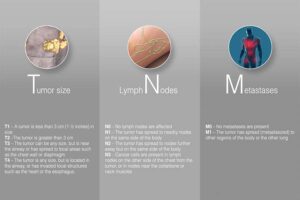Being able to differentiate a cancer into stages allows for you and your doctor to better understand how advanced your cancer is and how much it has spread. When your cancer is able to be categorized as a certain stage it can help your doctor determine the best treatment option for you.
What Is The TNM staging system?
The American Joint Committee on Cancer’s (AJCC) TNM staging system is widely recognized and used by cancer treatment facilities worldwide to describe different aspects of the tumor.
Factors of the TNM staging system:
T (tumor) : The size of the main tumor
N (Nodes) : Whether the prostate cancer has spread to lymph nodes
M (metastasis) : Whether the prostate cancer has spread to other parts of the body
For Prostate Cancer, the AJCC TNM staging system factors in PSA levels during prostate cancer diagnosis and the Gleason grade group, which is determined during a prostate biopsy. For a deeper dive into the TNM staging system, check out the informational graphic created by Girish Khera on our main blog page.
Prostate Cancer Stages
The primary stages of prostate cancer range from stage one to stage 4. It is important to note that some of these stages are broken down even further. (i.e. prostate cancer stage 2A) A common rule that is followed in this staging process is the lower the number (lowest being 1), the less the prostate cancer has spread. As for stages that are divided into substages, the earlier letter (A) refers to a lower stage.
It is important to note that each person’s prostate cancer experience is different and unique from one another. This staging system provides a common ground for cancers to be identified and categorized as best as possible. This has led to similar stages of cancer having similar outlooks and treatment paths.
We understand that prostate cancer can be complex. If you have any questions about what stage you or a loved one is in, you can reach out to us through the link at the bottom of the page, or call us during business hours.

